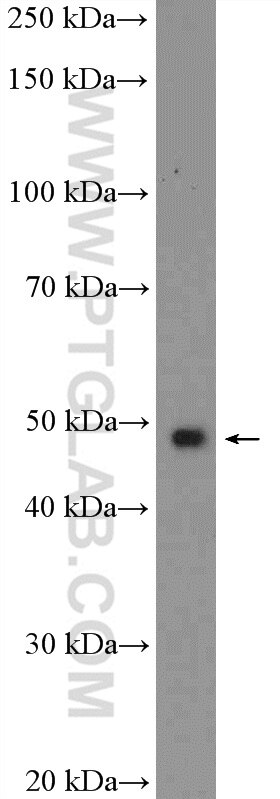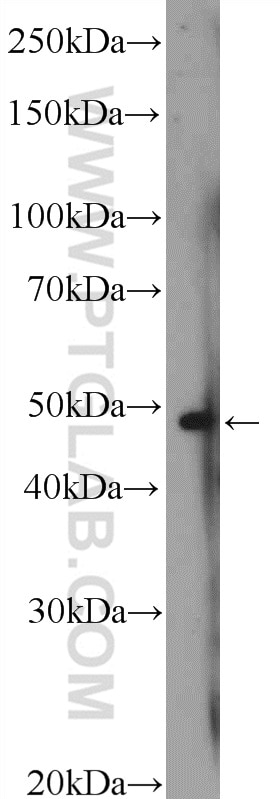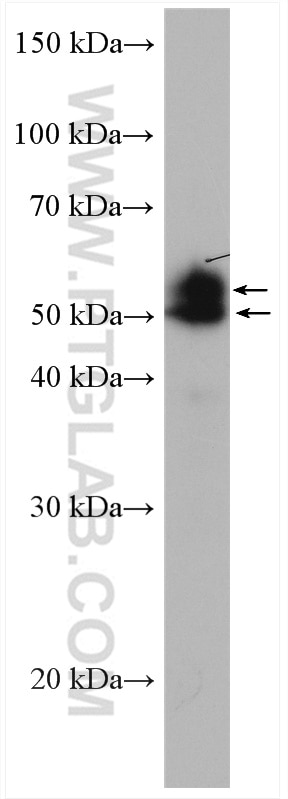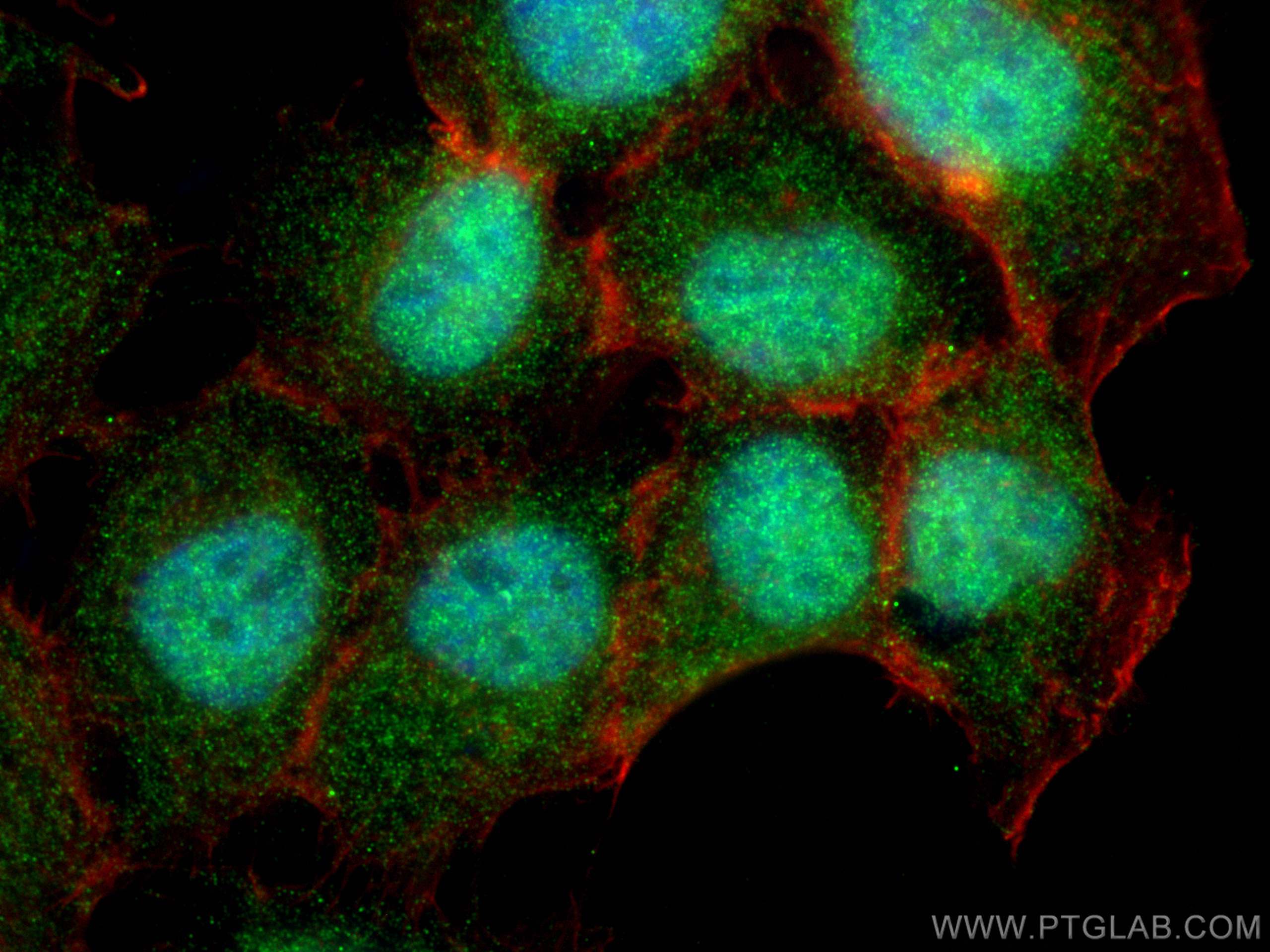MAZ Polyklonaler Antikörper
MAZ Polyklonal Antikörper für WB, IF/ICC, ELISA
Wirt / Isotyp
Kaninchen / IgG
Getestete Reaktivität
human, Maus
Anwendung
WB, IHC, IF/ICC, ChIP, ELISA
Konjugation
Unkonjugiert
Kat-Nr. : 21068-1-AP
Synonyme
Geprüfte Anwendungen
| Erfolgreiche Detektion in WB | HeLa-Zellen, Mauslungengewebe |
| Erfolgreiche Detektion in IF/ICC | A431-Zellen |
Empfohlene Verdünnung
| Anwendung | Verdünnung |
|---|---|
| Western Blot (WB) | WB : 1:500-1:1000 |
| Immunfluoreszenz (IF)/ICC | IF/ICC : 1:50-1:500 |
| It is recommended that this reagent should be titrated in each testing system to obtain optimal results. | |
| Sample-dependent, check data in validation data gallery | |
Veröffentlichte Anwendungen
| KD/KO | See 1 publications below |
| WB | See 5 publications below |
| IHC | See 1 publications below |
| IF | See 1 publications below |
| ChIP | See 1 publications below |
Produktinformation
21068-1-AP bindet in WB, IHC, IF/ICC, ChIP, ELISA MAZ und zeigt Reaktivität mit human, Maus
| Getestete Reaktivität | human, Maus |
| In Publikationen genannte Reaktivität | human, Maus |
| Wirt / Isotyp | Kaninchen / IgG |
| Klonalität | Polyklonal |
| Typ | Antikörper |
| Immunogen | MAZ fusion protein Ag15200 |
| Vollständiger Name | MYC-associated zinc finger protein (purine-binding transcription factor) |
| Berechnetes Molekulargewicht | 477 aa, 49 kDa |
| Beobachtetes Molekulargewicht | 49-55 kDa |
| GenBank-Zugangsnummer | BC041629 |
| Gene symbol | MAZ |
| Gene ID (NCBI) | 4150 |
| Konjugation | Unkonjugiert |
| Form | Liquid |
| Reinigungsmethode | Antigen-Affinitätsreinigung |
| Lagerungspuffer | PBS with 0.02% sodium azide and 50% glycerol |
| Lagerungsbedingungen | Bei -20°C lagern. Nach dem Versand ein Jahr lang stabil Aliquotieren ist bei -20oC Lagerung nicht notwendig. 20ul Größen enthalten 0,1% BSA. |
Hintergrundinformationen
Myc-associated zinc finger protein (MAZ) is a six zinc finger protein with a G-rich binding motif. MAZ is often found at genomic binding sites adjacent to CTCF, a protein which affects large-scale genome organization through its interaction with cohesin (PMID: 33558242). MAZ is widely expressed in most human tissues, such as heart, lung, brain, liver, placenta, testis, colon, peripheral blood leukocytes, skeletal muscle, thymus, pancreas, prostate, thyroid, and adrenal gland (PMID: 35098656). In cancer, MAZ has been proved to be highly expressed in malignant tumors, and to promote cancer progression and metastasis by regulating the transcription of downstream target genes through directly binding with target gene promoters or synergistic action with other transcription factors.
Protokolle
| PRODUKTSPEZIFISCHE PROTOKOLLE | |
|---|---|
| WB protocol for MAZ antibody 21068-1-AP | Protokoll herunterladen |
| IF protocol for MAZ antibody 21068-1-AP | Protokoll herunterladen |
| STANDARD-PROTOKOLLE | |
|---|---|
| Klicken Sie hier, um unsere Standardprotokolle anzuzeigen |
Publikationen
| Species | Application | Title |
|---|---|---|
Oxid Med Cell Longev TUG1/MAZ/FTH1 Axis Attenuates the Antiglioma Effect of Dihydroartemisinin by Inhibiting Ferroptosis | ||
Genomics PLOD1 promote proliferation and migration with glycolysis via the Wnt/β-catenin pathway in THCA | ||
Alzheimers Res Ther Uncovering the epigenetic regulatory clues of PRRT1 in Alzheimer's disease: a strategy integrating multi-omics analysis with explainable machine learning | ||
Commun Biol Molecular mechanisms of MAZ targeting up-regulation of NDUFS3 expression to promote malignant progression in melanoma | ||
Oncogene YBX1 promotes 5-Fluorouracil resistance in gastric cancer via m5C-dependent ATG9A mRNA stabilization through autophagy
|





